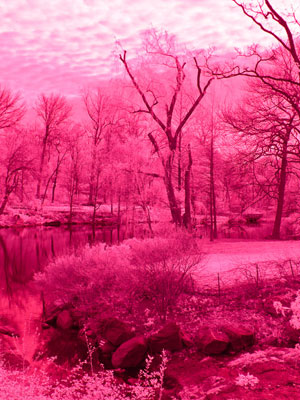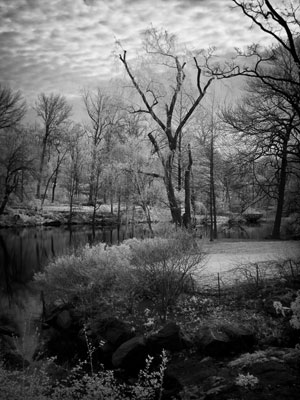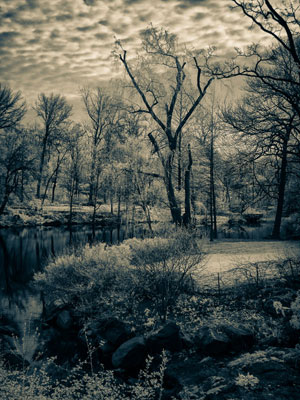Alternative Processes
Infrared
|
Initial Infrared Image |
Conversion to Black & White |
Conversion to Split Tone |
Infrared (IR) photography began with the development of a sensitized film that can “read” light waves not normally picked up from the full light spectrum. Digital cameras can be converted with a special filter that blocks all but IR light. Either with film or digital, the black and white effects (especially with landscapes and skyscapes) are dramatic and, at times, eerie. The initial pink and black digital image must be converted to black and white.
Split Tone
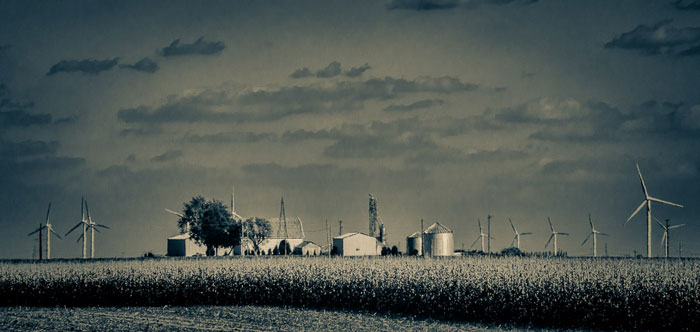
Converted from Black & White to Split Tone
If I find some of my black and white images to be somewhat harsh, I proceed to a digital process called split toning. This process had its origins in the darkroom where a print would be treated with two chemical toning baths. Either process -- chemical or digital -- results with the shadows and highlights becoming toned in subtle hues, usually of blues, sepias or terra cottas. Throughout these galleries split toned images appear, whether having started out as infrared, black and white, or color.
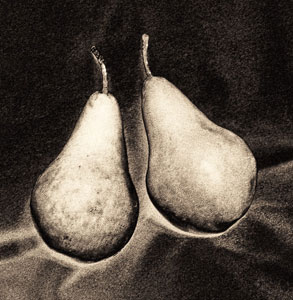 |
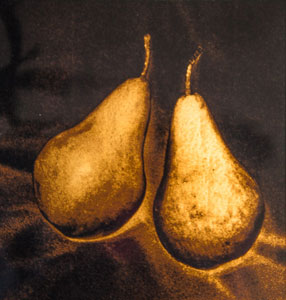 |
Gold Tone
Each of my gold toned prints is one-of-a-kind. It begins as a graphically strong black and white image that is printed on transparent film, followed by the application of a metallic paint. The effect is beautiful and, at times, nearly three-dimensional. A print generally takes about two days to complete. Application of the paint is painstaking; but that is what gives the print its uniqueness. The size generally will be no larger than 11” x 14”. Photographing gold-tone prints is difficult; much is lost in translation.
Pinhole
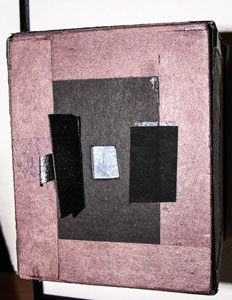 |
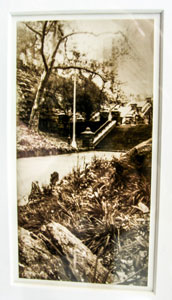 |
Many children are introduced to photography with the project of making a pinhole camera out of an oatmeal container. Pinhole cameras are lens-less cameras (derived from the Latin meaning rooms) which can contain light sensitive paper, or film. In its crudest form a small sewing pin is stuck into the side of the box for the aperture. I've made several light-tight boxes with a cut-out 1" hole in the center and a piece of thin metal taped over the hole. In the center of the metal a tiny hole was drilled to create an aperture of approximately f140. Such a tiny aperture requires some guessing as to exposure time: on a sunny day about 5 seconds.
The advantage of using pinhole cameras is that the tiny aperture allows for infinite depth of field. The edges of an image are usually splayed and vignetted in interesting ways. Advocates of “krappy kamera” photography are found throughout the world and krappy kamera competitions abound. Placing a pinhole lens onto a digital camera isn’t particularly successful. Krappy photography gets clearest results with use of film; but light-sensitive paper has its own softer charm. Pinhole cameras have ranged from match boxes to giant rooms. Long before photography, artists used the camera obscura to project a reflected scene upside-down on a rear wall, in order to be able to copy it.
